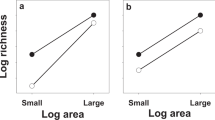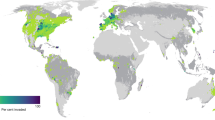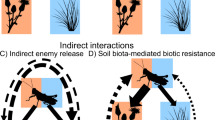Abstract
Human activity is creating a global footprint by changing the climate, altering habitats and reshuffling the distribution of species. The movement of species around the globe has led to the naturalization and accumulation of multiple non-native species within ecosystems, which is frequently associated with habitat disturbance and changing environmental conditions. However, interactions among species will also influence community composition, but little is known about the full range of direct and indirect interactions among native and non-native species. Here, we show through a meta-analysis of 1,215 pairwise plant interactions between 274 vascular plant species in 21 major habitat types that interactions between non-native plants are asymmetrical with interactions between non-native and native plants. Non-native plants were always bad neighbours, but the negative effect of non-natives on natives was around two times greater than the effect of non-natives on other non-natives. In contrast, the performance of non-native plants was five times higher in the presence of a neighbouring native plant species than in the presence of a neighbouring non-native plant species. Together, these results demonstrate that invaded plant communities may accumulate additional non-native species even if direct interactions between non-natives species are negative. Put another way, invasions may be more likely to lead to more invasions, requiring more active management of ecosystems by promoting native species restoration to undermine invasive positive feedback and to assist native species recovery in invaded ecosystems.
This is a preview of subscription content, access via your institution
Access options
Subscribe to this journal
Receive 12 digital issues and online access to articles
$119.00 per year
only $9.92 per issue
Buy this article
- Purchase on Springer Link
- Instant access to full article PDF
Prices may be subject to local taxes which are calculated during checkout




Similar content being viewed by others
References
Chytrý, M. et al. Habitat invasions by alien plants: a quantitative comparison among Mediterranean, subcontinental and oceanic regions of Europe. J. Appl. Ecol. 45, 448–458 (2008).
van Kleunen, M. et al. Global exchange and accumulation of non-native plants. Nature 525, 100–103 (2015).
Vilà, M. & Weiner, J. Are invasive plant species better competitors than native plant species? – evidence from pair-wise experiments. Oikos 105, 229–238 (2004).
Simberloff, D. & Von Holle, B. Positive interactions of nonindigenous species: invasional meltdown? Biol. Invasions 1, 21–32 (1999).
Catford, J. A., Jansson, R. & Nilsson, C. Reducing redundancy in invasion ecology by integrating hypotheses into a single theoretical framework. Divers. Distrib. 15, 22–40 (2009).
Jeschke, J. M. et al. Support for major hypotheses in invasion biology is uneven and declining. NeoBiota 14, 1–20 (2012).
Kuebbing, S. E., Simberloff, D. & Nuñez, M. A. Current mismatch between research and conservation efforts: The need to study co-occurring invasive plant species. Biol. Conserv. 160, 121–129 (2013).
Simberloff, D. Invasional meltdown 6 years later: important phenomenon, unfortunate metaphor, or both? Ecol. Lett. 9, 912–919 (2006).
Kuebbing, S. E. & Nuñez, M. A. Negative, neutral, and positive interactions among nonnative plants: patterns, processes, and management implications. Glob. Change Biol. 21, 926–934 (2015).
Flory, S. L. & Bauer, J. T. Experimental evidence for indirect facilitation among invasive plants. J. Ecol. 102, 12–18 (2014).
Zarnetske, P. L., Gouhier, T. C., Hacker, S. D., Seabloom, E. W. & Bokil, V. A. Indirect effects and facilitation among native and non-native species promote invasion success along an environmental stress gradient. J. Ecol. 101, 905–915 (2013).
Cushman, J. H., Lortie, C. J. & Christian, C. E. Native herbivores and plant facilitation mediate the performance and distribution of an invasive exotic grass. J. Ecol. 99, 524–531 (2011).
Callaway, R. M. & Walker, L. R. Competition and facilitation: a synthetic approach to interactions in plant communities. Ecology 78, 1958–1965 (1997).
Kettenring, K. M. & Adams, C. R. Lessons learned from invasive plant control experiments: a systematic review and meta-analysis. J. Appl. Ecol. 48, 970–979 (2011).
Pearson, D. E., Ortega, Y. K., Runyon, J. B. & Butler, J. L. Secondary invasion: the bane of weed management. Biol. Conserv. 197, 8–17 (2016).
Henriksson, A., Wardle, D. A., Trygg, J., Diehl, S. & Englund, G. Strong invaders are strong defenders – implications for the resistance of invaded communities. Ecol. Lett. 1–12 (2016).
Bulleri, F., Bruno, J. F. & Benedetti-Cecchi, L. Beyond competition: Incorporating positive interactions between species to predict ecosystem invasibility. PLoS Biol. 6, 1136–1140 (2008).
Bruno, J. F., Stachowicz, J. J. & Bertness, M. D. Inclusion of facilitation into ecological theory. Trends Ecol. Evol. 18, 119–125 (2003).
Cavieres, L. A., Quiroz, C. L., Molina-Montenegro, M. A., Muñoz, A. A. & Pauchard, A. Nurse effect of the native cushion plant Azorella monantha on the invasive non-native Taraxacum officinale in the high-Andes of central Chile. Perspect. Plant. Ecol. Evol. Syst. 7, 217–226 (2005).
Bonanomi, G., Incerti, G. & Mazzoleni, S. Assessing occurrence, specificity, and mechanisms of plant facilitation in terrestrial ecosystems. Plant Ecol. 212, 1777–1790 (2011).
Maron, J. L. & Connors, P. G. A native nitrogen-fixing shrub facilitates weed invasion. Oecologia 105, 302–312 (1996).
Richardson, D. M. & Pyšek, P. Naturalization of introduced plants: ecological drivers of biogeographical patterns. New Phytol. 196, 383–396 (2012).
Louda, S. M., Keeler, K. H. & Holt, R. D. in Perspectives on Plant Competition 413–444 (Academic Press, Inc., 1990).
Parker, J. D., Burkepile, D. E. & Hay, M. E. Opposing effects of native and exotic herbivores on plant invasions. Science 311, 1459–1461 (2006).
Mitchell, C. E. et al. Biotic interactions and plant invasions. Ecol. Lett. 9, 726–740 (2006).
Goldberg, D. E. & Barton, A. M. Patterns and consequences of interspecific competition in natural communities: a review of field experiments with plants. Am. Nat. 139, 771–801 (1992).
Gurevitch, J., Morrow, L. L., Wallace, A. & Walsh, J. S. A meta-analysis of field experiments on competition. 4, 539–572 (1992).
Brooker, R. W. et al. Facilitation in plant communities: the past, the present, and the future. J. Ecol. 96, 18–34 (2008).
Iponga, D. M., Milton, S. J. & Richardson, D. M. Soil type, microsite, and herbivory influence growth and survival of Schinus molle (Peruvian pepper tree) invading semi-arid African savanna. Biol. Invasions 11, 159–169 (2009).
Werner, C., Zumkier, U., Beyschlag, W. & Máguas, C. High competitiveness of a resource demanding invasive acacia under low resource supply. Plant Ecol. 206, 83–96 (2010).
Lau, J. A. & Strauss, S. Y. Insect herbivores drive important indirect effects of exotic plants on native communities. Ecology 86, 2990–2997 (2005).
Baude, M. et al. Litter inputs and plant interactions affect nectar sugar content. J. Ecol. 99, 828–837 (2011).
Engel, E. C. & Weltzin, J. F. Can community composition be predicted from pairwise species interactions? Plant Ecol. 195, 77–85 (2008).
Fortner, A. M. & Weltzin, J. F. Competitive hierarchy for four common old-field plant species depends on resource identity and availability. J. Torrey Bot. S. 134, 166–176 (2007).
Mariotte, P., Buttler, A., Johnson, D., Thébault, A. & Vandenberghe, C. Exclusion of root competition increases competitive abilities of subordinate plant species through root-shoot interactions. J. Veg. Sci. 23, 1148–1158 (2012).
Vasquez, E., Sheley, R. L. & Svejcar, T. Creating invasion resistant soils via nitrogen management. Invas. Plant Sci. Manag. 1, 304–314 (2008).
James, J. J., Drenovsky, R. E., Monaco, T. A. & Rinella, M. J. Managing soil nitrogen to restore annual grass-infested plant communities: effective strategy or incomplete framework? Ecol. Appl. 21, 490–502 (2011).
Keane, R. M. & Crawley, M. J. Exotic plant invasions and the enemy release hypothesis. Trends Ecol. Evol. 17, 164–170 (2002).
Brooker, R. W. Plant-plant interactions and environmental change. New Phytol. 171, 271–284 (2006).
Keddy, P. A. Competition. 1–565 (Springer Science+Business Media, 2001).
IUCN. Habitats Classification Scheme. 1–14 (International Union for the Conservation of Nature, 2012).
Rosenberg, M. S., Adams, D. C. & Gurevitch, J. Metawin: Statistical software for meta-analysis (Sinauer Associates, 2000).
Elton, C. S. The Ecology of Invasions by Animals and Plants (Metheun, 1958).
Levine, J. M., Adler, P. B. & Yelenik, S. G. A meta-analysis of biotic resistance to exotic plant invasions. Ecol. Lett. 7, 975–989 (2004).
Acknowledgements
We thank L. Smith, M. Rodriguez-Cabal, D. Maynard and N. Sanders and four anonymous reviewers for comments on previous versions of the manuscript.
Author information
Authors and Affiliations
Contributions
S.E.K. and M.A.N. developed the approach and initial idea for the research. S.E.K. extracted and analysed the data, and led the writing of the manuscript. M.A.N. contributed substantially to the interpretation of the results and to the final version of the manuscript.
Corresponding author
Ethics declarations
Competing interests
The authors declare no competing financial interests.
Supplementary information
Supplementary Information
Supplementary Tables 1-3, Supplementary Extended Data Figures 1-3, Supplementary Equation 1. (PDF 1666 kb)
Supplementary Extended Data File.
Observation row of data. (CSV 349 kb)
MetaData
Supplementary Extended Data Column Descriptions. (XLSX 12 kb)
Rights and permissions
About this article
Cite this article
Kuebbing, S., Nuñez, M. Invasive non-native plants have a greater effect on neighbouring natives than other non-natives. Nature Plants 2, 16134 (2016). https://doi.org/10.1038/nplants.2016.134
Received:
Accepted:
Published:
DOI: https://doi.org/10.1038/nplants.2016.134
This article is cited by
-
Investigating the phenology and interactions of competitive plant species co-occurring with invasive Lantana camara in Indian Himalayan Region
Scientific Reports (2024)
-
Do chill hours and soil moisture limit the germination of Elaeagnus angustifolia?
Plant Ecology (2024)
-
How ecological and evolutionary theory expanded the ‘ideal weed’ concept
Oecologia (2023)
-
Competition effect exerted by two nonnative invasive plant species on a native under contrasting conditions of resource availability
Biological Invasions (2023)
-
An exotic plant species indirectly facilitates a secondary exotic plant through increased soil salinity
Biological Invasions (2023)



